Pingdom Server Monitor
SolarWinds' Pingdom Server Monitor (formerly known as Scout Server Monitoring) delivers software for monitoring and managing networks and systems. When events meet predetermined criteria, this integration with xMatters relays critical Pingdom insight data to the correct people and systems to help coordinate and resolve incidents faster.
Install the workflow
Here's how to install the Pingdom Server Monitor workflow through the xMatters one-click installation process. If you already installed the previous, built-in version of the integration, you can find instructions here.
- Go to the Workflow Templates page and click the PingdomSM tile.
- On the Set up the Workflow tab, give the workflow a name that identifies its purpose (this must be unique in your instance), add an optional description, and set the default incident type (if applicable). Any built-in Initiate Incident steps in the workflow will automatically be set to the selected incident type.
- You can edit these later, if needed.

- You can edit these later, if needed.
- Click Next to set up the connection.
- Copy the trigger URL — you’ll use this to configure the webhook in PingdomSM.
- The trigger URL includes the recipients parameter, which specifies who should be notified. By default, this parameter is set to notify you (the logged in user), but you can set it to target any user or group you want.
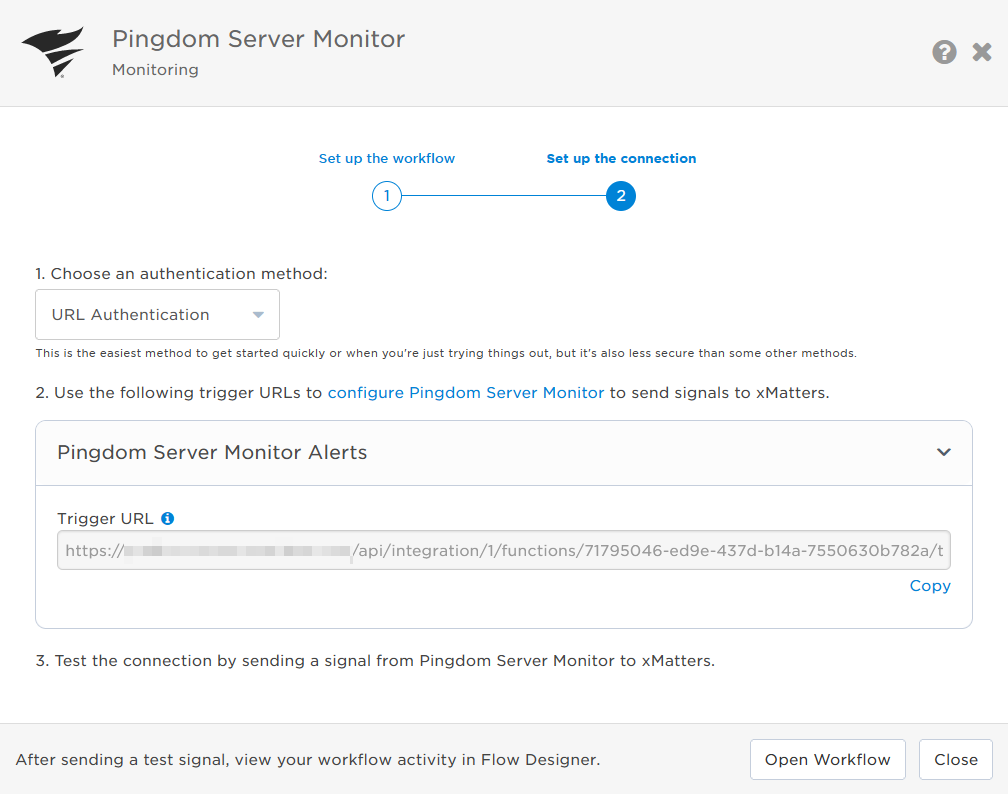
- The trigger URL includes the recipients parameter, which specifies who should be notified. By default, this parameter is set to notify you (the logged in user), but you can set it to target any user or group you want.
- Send a test signal to the trigger URL to test the connection.
- Click Open Workflow.
Configure Pingdom Server Monitor to send requests to the trigger URL
To have Pingdom Server Monitor send alerts to the flow trigger, you need to configure a webhook and set it to use the trigger URL.
- On the Pingdom Server Monitor homepage, go to your company settings drop-down menu (located on the top-right corner of the screen), and select Notifications.
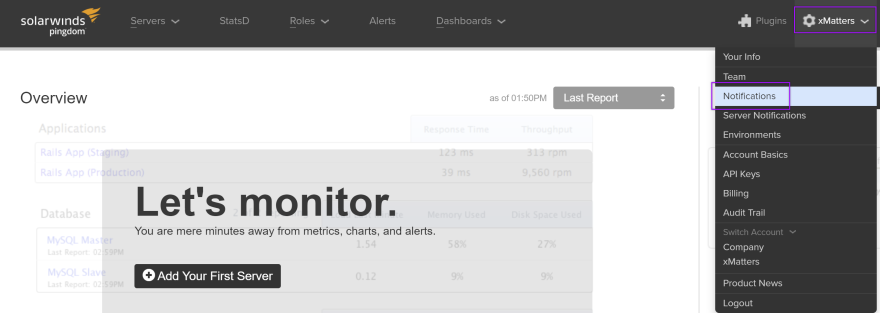
- Under Notification Channels, click Add Webhook to create a new webhook.

- On the New Webhook page, fill in the following fields:
- Webhook Name: give your webhook a unique, descriptive name.
- Webhook URL: paste the URL you copied from the Pingdom Server Monitor Alerts trigger in Flow Designer.
- Add the target names of any recipients you want to notify when the monitor creates an alert to the end of the URL.
- For URL authentication, use an ampersand to attach recipients. For example, if you want to notify Emma Pearson and the on-call members in the group responsible for the Antares service, you'd add &recipients=epearson,antares to the URL.
- You must URL-encode any special characters or spaces in the target names.

- Click Submit to create the webhook.
- To check that alerts go to the right recipients, click Send a test post.

You're ready to use the webhook to trigger automated flows, including steps such as sending alerts and initiating incidents, though we always recommend testing before putting things into use.
Set recipients in the trigger URL
The trigger expects the recipients in the trigger URL. When you copy the URL from xMatters, it includes the recipients parameter: &recipients=<yourname>. Of course, you don’t want to receive all the alerts.
To change the recipients for alerts from this webhook, swap out your name for the people or groups you want to target. For example, to target the 'DatabaseTeam', 'Antares Service Team', and 'HR & Marketing' groups, add &recipients=databaseteam,antares%20service%20team,HR%20%26%20Marketing to the trigger URL. Remember to URL-encode any special characters, including spaces, in your group names.
We recommend using groups so you can take advantage of the xMatters group features — rotations, escalations, and absences — to reach the right on-call people to jump on an issue.
How to use the workflow
When a condition you've set fires, it sends a signal to xMatters, which creates an alert and notifies the individual or the on-call members of the people or groups you set as recipients in the webhook URL. When the trigger receives a signal saying the issue is resolved, it automatically terminates related alerts in xMatters.
The person responding to the notification has the following response options:
- Acknowledge: Acknowledges the notifications and stops escalations.
- Escalate: Immediately escalates the alert to the next on-call resolver in a targeted group.
- Close: Ends the xMatters alert and stops notifying all targeted recipients.
- Initiate Incident: Initiates an incident in xMatters.
Next Steps
Now that you've installed the Pingdom Server Monitor workflow, you can use it as-is, or customize it to suit your needs better. Here are some examples of things you can add to the workflow to customize it:
- Use Slack, Zoom, and Microsoft Teams steps to add collaboration channels to the flow.
- Change the severity of incidents created when a recipient selects the Initiate Incident response.
- Update the message sent to resolvers to include the information most relevant to your team.
- Use the Pingdom Server Monitor Alerts trigger to build your own custom flows.
Previous versions
While the previous, built-in version of this integration is no longer available, the instructions for it are included below for anyone who has it installed in their system already.
xMatters automates communications by integrating people into your toolchains so you can proactively prevent outages, rapidly engage resolvers, manage major incidents, and keep stakeholders informed.
Do more with this integration
Incorporate this integration into your orchestrated incident resolution workflows with Flow Designer. After you create a configuration, the Flows tab appears. From there, you can build your flows — add new response options, connect to other apps, or even create new xMatters alerts based on activities in the flow — enriching the information injected by this integration along the way.
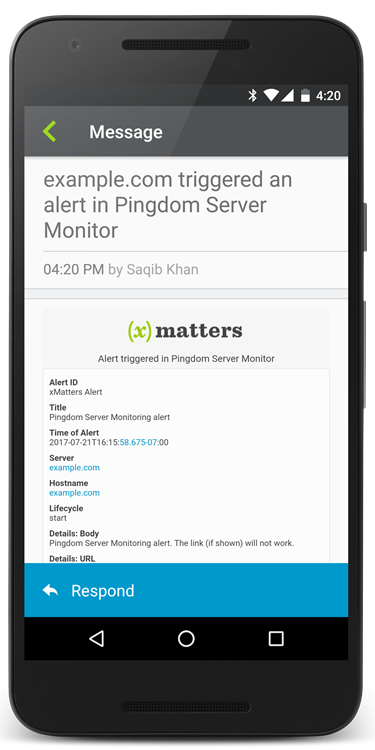
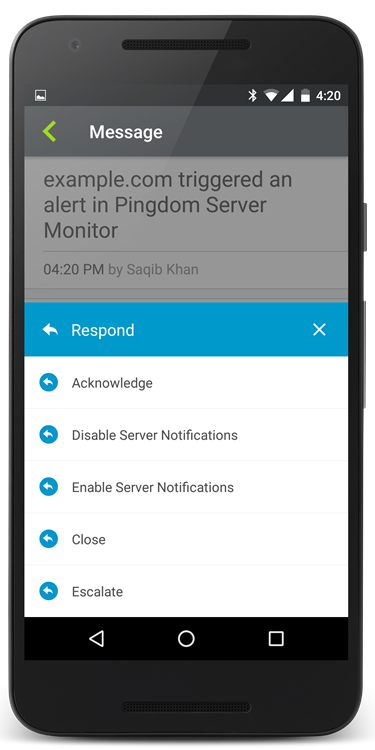
To install this integration in xMatters, simply go to Workflow Templates on the Workflows tab and start typing the name of the integration you're looking for to filter the list. Once you find it, click its tile then click Next to get to the configuration screen.
How to set up a Pingdom Server Monitor configuration
After you give your configuration a name and description, type a name to use when sending alerts (so you can easily tell which configuration or integration the alerts are from), and add all of the people or groups you want to be notified.
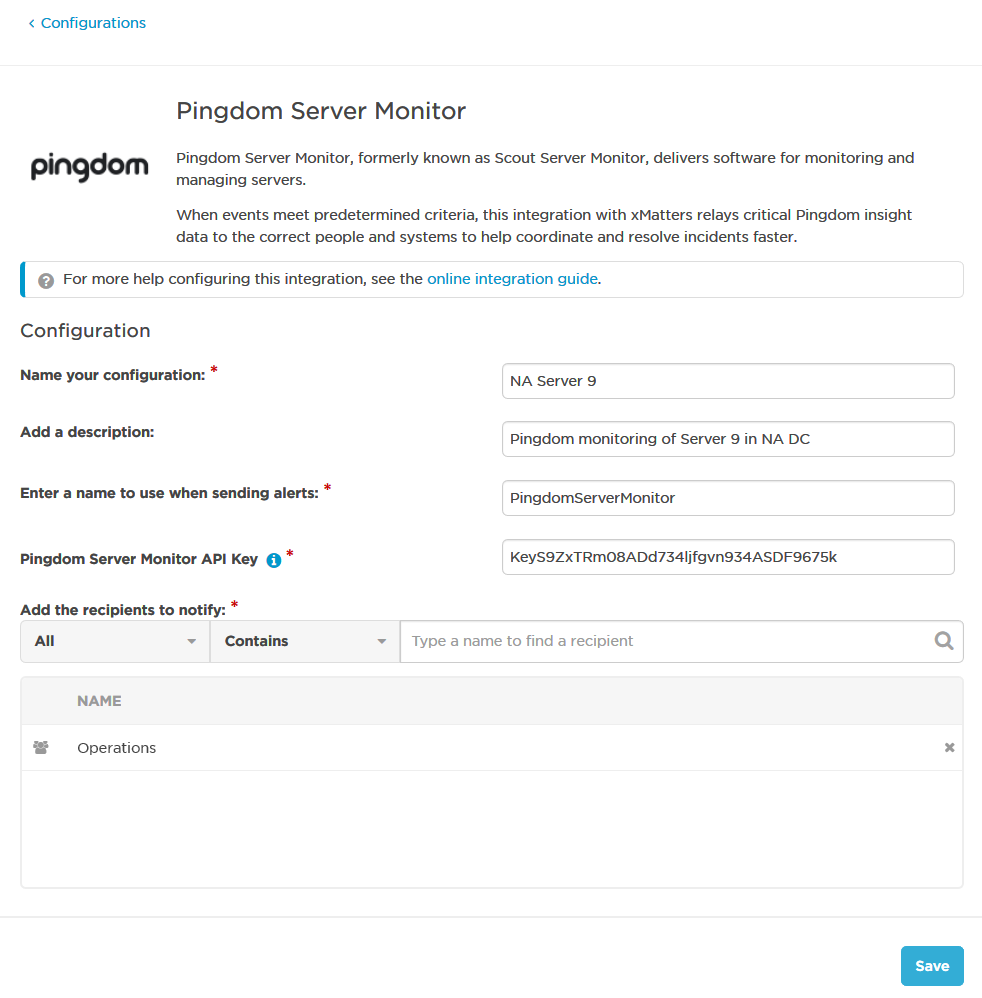
Next, create a new API key in Pingdom to use with xMatters, enter it in the Pingdom Server Monitor API Key field, and then click Save.
- Log into Pingdom, navigate to your account profile, and then click API Keys.
- Click Add API Key to generate a new API key for xMatters.
- Pingdom recommends creating a new key for each system you want to connect.
- Copy and paste the new key into the Pingdom Server Monitor API Key field on the configuration page in xMatters.
Once you save the configuration, xMatters displays the settings you need to configure Pingdom:

Use this URL as the target for a webhook, and add the webhook to a notification group.
- In Pingdom, navigate to your account profile, and then click Notifications.
- Under Notification Channels, click Add Webhook.
- Give your webhook a name so you can identify it (such as "xMatters Webhook"), and paste the URL from the configuration page in xMatters into the URL field:

- Return to the Notifications screen and create a notification group (or edit an existing group), and select the xMatters xMatters for notifications.
Your integration is now complete!
Whenever an alert is triggered in Pingdom that targets a notification group using your xMatters webhook, xMatters will notify your selected recipients.
To test whether your integration is working, trigger an alert in Pingdom that targets the notification group that you configured with the xMatters webhook.
When the alert is triggered, Pingdom will send event information to xMatters, which will send notifications to the recipients you specified on the configuration page. Recipients can select from the following response options:
- Acknowledge: assigns the alert to the responder, and stops notifying other recipients.
- Disable Server Notifications: stops notifying the responder, and tells Pingdom not to send anymore notifications involving the server that triggered the alert. (This response clears the "Enable Notifications" check box for this server on the Server Notifications Settings page in Pingdom.)
- Enable Server Notifications: stops notifying the responder, and tells Pingdom to enable notifications for the related server. (This response selects the "Enable Notifications" check box for this server on the Server Notifications Settings page in Pingdom.)
- Close: stops notifying all recipients and terminates the alert.
- Escalate: stops notifying the responder about the alert, and immediately escalates the notification to the next available group member defined in xMatters.
xMatters sends the response back to Pingdom, and records the information in a marker on the Alerts tab:
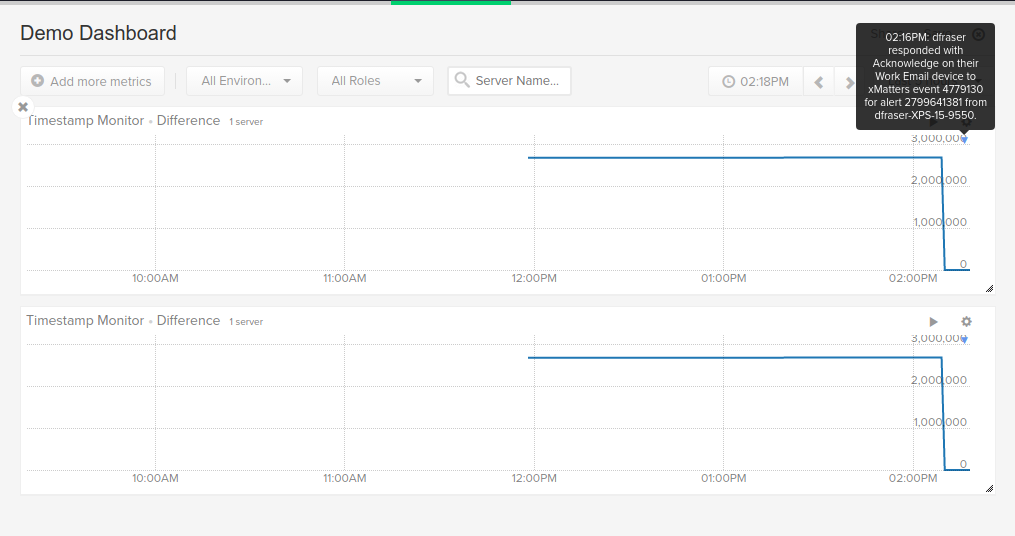
Extending your integration
Looking to do more with xMatters and Pingdom Server Monitor? If you want to tailor the settings and notifications for the integration, you can convert it to a custom workflow.
